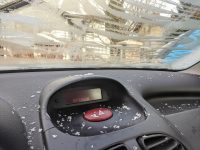
How To Remove Frost Inside Your Windshield Quickly And Easily
Driving with frost inside the windshield can be dangerous because of the vision obstruction that it can result in, and you’ll always want a clear windshield.
If you’ve ever driven in cold weather and watched frost inside your windshield form and drip, you know that it can be dangerous to drive with that extra layer of ice on your windshield. By the time you realize there’s a problem, it may be too late to avoid an accident. But it doesn’t have to be this way!
It always helps to have some tips and guidelines to follow to get rid of frost inside the windshield, and trying out a combination of these tips will result in safer driving.
Use Command Start To Heat The Car Before Getting Inside
Modern cars use a computerized method of detecting when you’re ready to drive by using sensors in your key fob. When those sensors tell your car you’re coming, it automatically turns on its climate control system, which pre-heats your engine before you climb behind the wheel.
If you let your car sit with its windows open or don’t get in for some other reason, that heat may be trapped inside—which could cause your windshield to freeze over as if it were an ice rink.
If your car has built-in navigation, you can use it to program it not to activate climate control until after a set amount of time passes. This setting is called climate delay or something similar; look for it under climate in your infotainment menu.
It’s recommended to set your climate delay at least five minutes long, which should be enough time for you to get inside, close your door and start driving before anything starts getting warm or cold.
Some cars will also let you program a distance requirement as well, requiring that you drive a certain number of feet before activating auto climate control.
Clear The Window
The best way to clear your windshield of frost is with a window de-icer. There are two types you can use: those that work on contact, or those that go on before you leave in the morning.
If you choose a solution that goes on in advance, make sure it isn’t too strong or it might crack your windshield—and be aware it might create white residue around your car when it dries.
If you want to avoid these downsides, pick up some contact-style de-icer instead; simply spray it on as soon as you notice ice forming (typically during pre-dawn hours) and let dry naturally.
Leave The Window Open A Crack
Leaving your car window slightly open overnight can help prevent moisture from building up in your car’s interior, which can reduce frost buildup. Just remember to leave a warm item (like a heated towel) in your backseat, or you’ll have fog on your windscreen by morning.
This should do it for most cars; if you have a truck or SUV with a large windshield or windows that are tinted, follow some of these additional tips for better results.
Apply The Heat
Heating up your car’s windshield with a hair dryer or heat gun makes it easier to clear off frost. This process requires some finesse, as using too much heat can result in cracking.
To apply heat, park your car in an open area (like your driveway), put on some work gloves and start clearing away snow from one corner of your windshield at a time, working from the top-down.
After you’ve cleared off all of that snow, switch sides of your car (left side/right side) so you don’t have any missed spots.
Consider Using Chemicals
Some chemicals are made specifically for removing frost, which is a mixture of tiny frozen droplets and supercooled water. The trick with chemical sprays is you have to spray before it actually freezes onto your glass, so you have to be vigilant about checking your windshield throughout winter.
Once your car has started moving, pull over immediately if you see any foggy areas on your windshield. Spray any surface that’s covered in frost—that way once it melts away from one area, it won’t refreeze on another section of glass.
Since cold temperatures cause water droplets to expand into ice-like crystals, if you can remove them before they have a chance to refreeze, chances are good your windshield will remain clear even as temperatures continue dropping.
Scrape The Windshield
This can take anywhere from five minutes to half an hour, depending on how bad it is. Just scrape off as much of the frost as you can with a squeegee, ice scraper, or something else that won’t scratch your windshield.
Then use hot water, starting at one corner and slowly moving around in a circle. You might have to repeat it several times before you get all of it off. If you still have some after 15 minutes or so of scraping/wiping, put a towel on your dashboard or stick it in front of your defroster for about 10-15 minutes. The towel will warm up and melt off any leftover frost when you pull it away!
Final Thoughts
No one wants to be risking their safety by driving on the road with a frosted-up windshield. While you might freeze a bit while cleaning your windshield before you drive, it beats paying the consequences of an automobile accident.



